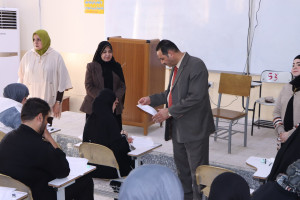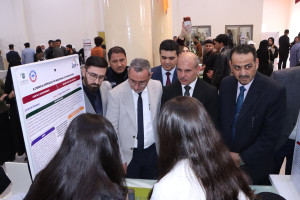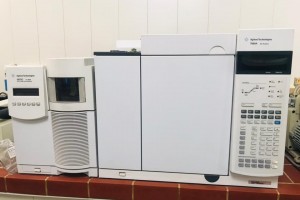
The College of Education for Pure Sciences at the University of Basrah discussed a PhD thesis on (the dynamics of electron transport in a qubit associated with a quantum contact point)
The thesis presented by the researcher (Ayat Taher Ibrahim) included
In this work, the quantum point contact was studied as a detector of charge qubits. A quantum dot is essentially a channel of one-dimensional conductive material. To study qubit dynamics, it is required to know the number of quantum dots occupying the qubit and the current flowing through the quantum contact point. The theoretical treatment was accomplished by deriving the differential complementary kinematic equations using the Heisenberg representation to prepare the occupations for the quantum dots and for all exchange functions. The equations of motion form a closed set, which have been solved numerically using the Range Kota method of the sixth degree. It is hypothesized that the two reservoirs (reservoirs) in the quantum junction point are composed of a full Kraven slice. Quantum dot occupancy calculations were used to determine the annealing state. All special coefficients for examining the quantitative process were highlighted during the quantitative efficiency calculation. The case of a qubit composed of two symmetric and asymmetric quantum dots was studied in both the strong and weak approaches. Our manipulation showed that under appropriate conditions and with a correct analysis of the experimental results (ie the preparation of quantum dot occupations), useful information about the state of the qubit can be found.
Thesis concluded
An increased variability in the quantum contact point tunneling barrier leads to faster entanglement between qubits and measuring devices. Therefore, increasing the scaling intensity breaks down entangled qubit levels more quickly. It is possible to notice a decrease in the dephasing time, measurement time and quantum efficiency with an increase in the change in the quantum focal point tunneling barrier. We have concluded that the phase time increases with the increase in bias voltage. Therefore, the quantitative efficiency can be enhanced by controlling the bias voltage, while the measurement time increases with the bias voltage. As an increase in measurement time leads to a decrease in quantitative efficiency. This means that the circumferential effect can be controlled by increasing the bias voltage as an auxiliary factor, taking into account the role of the density of the electrode states (complete graphene) in determining these features. The role of the density formula of semi-elliptical states of reservoirs and by section was also studied and discussed.
According to our entire study, we conclude that our theoretical treatment is quite suitable for examining any quantum junction reservoirs with restricted dimensions with the aim of reaching high quantum efficiency.
The aim of the thesis
Aims to study electron dynamics in a qubit coupled to a quantum junction with graphene reservoirs. This goal can be reached through the following:
Derivation of the integral differential kinematic equations that describe the electron dynamics during the quantum measurement process.
Examining the role of all parameters that can be practically controlled, such as the energy levels of the two quantum oils and the energy gap between them, as well as the coupling interaction between the two quantum dots and the coupling interaction between the reservoirs of the quantum junction point, where the non-coupling mechanics of the qubit were neglected.
Executing an extended calibration model for symmetric and asymmetric quantum dots in the strong and weak coupling approaches, in order to control the measurement time and the time of non-phase, and thus the quantum efficiency that determines the state of disorganization.









